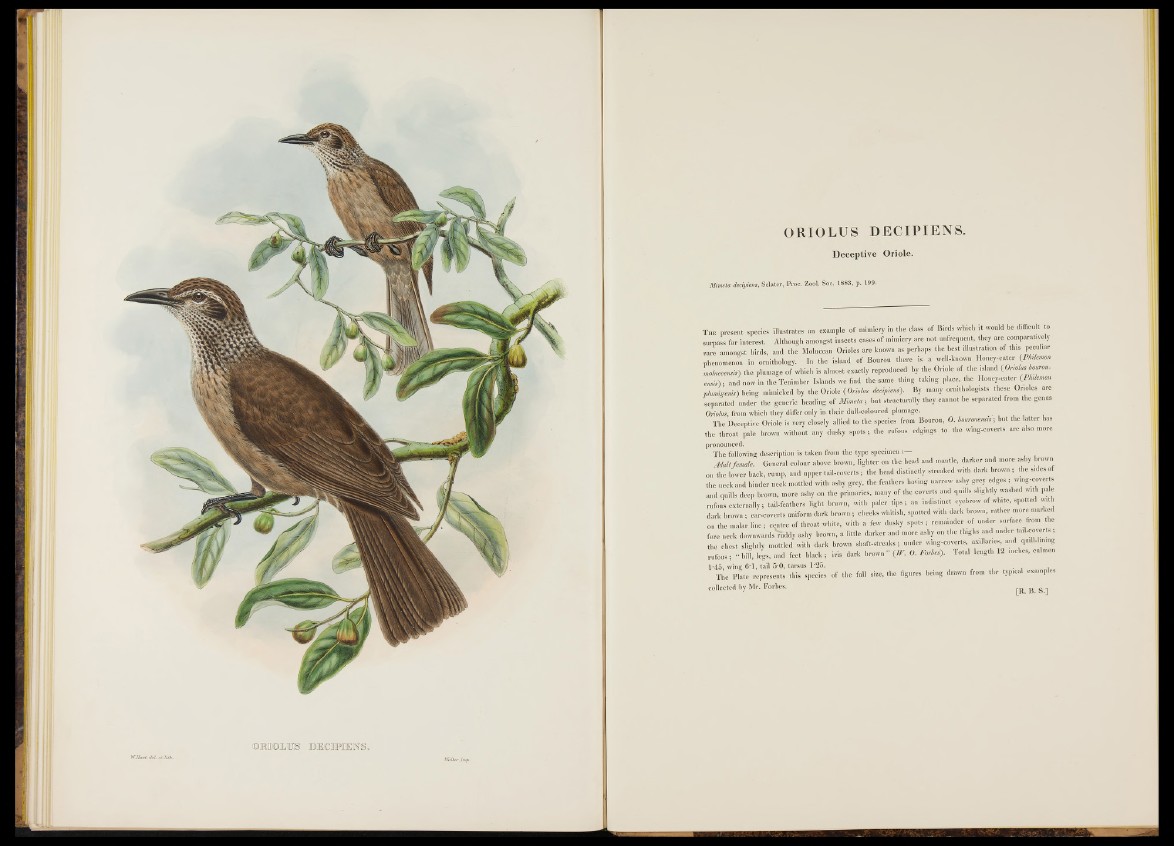
ORIOLUS DECIPIENS .
Deceptive Oriole.
Mimeta decipiens, Sclater, Proc. Zool. ¡Soc. 1883, p. 199-
T h e present species illustrates an example of mimicry in the class o f Birds which it would be difficult to
surpass for interest. Although amongst ,iji||cts cases o f mimicry are not unfrequent; they are comparatively
rare amongst birds, and the Moluccan Orioles are known as perhaps the best illustration o f this peculiar
phenomenon in ornithology. In the Ä n d o f Bourou there is a well-known Honey-eater {P h lem m
WHKÊSÊ the plumage of which«* almost exactly reproduced by the Oriole of the island (Oriolus bourou-
ensis); and n o w in the Tenimber Islands we 6nd the same thing taking place, the Honey-eater (PMotcw
plumigenis) being mimicked by the Oriole (O n o te decipiens). By many ornithologists these Orioles are
separated under the generic heading of Mimeta ; but structurally they cannot be separated from the genus
Oriolus, from which they differ only in their dull-coloured plumage.
The Deceptive Oriole is very closely allied to the species from Bourou, 0 . bourouenm ; but the latter has
the throat pale brown without any dusky spots ; the rufous edgings to the wing-coverts are also more
pronounced.
The following description is taken from the type specimen
A dult female. General colour above brown, lighter on the head and mantle, darker and more ashy brown
on the lower back, rump, and upper tail-eoverts ; the head distinctly streaked with dark brown s. the sides of
the neck and hinder neck mottled with ashy grey, the feathers having narrow ashy grey edges ; wing-coverts
and quills deep Brown, more ashy on the primaries, many of the coverts and quills slightly washed with pale
rufous externally; tail-feathers light brown, with paler tips; an indistinct e y e b r o w of white, spotted with
dark brown ; ear-coverts uniform dark brown ; cheeks whitish, spotted with dark brown, rather more marked
on the malar line; centre of throat white, with a few dusky spots; remainder of under surface from the
■ fore neck downwardsVuddy ashy brown, a little darker and more ashy on the thighs and under tail-coverts ;
the chest slightly mottled with dark brown shaft-streaks ; under wing-coverts, axillanes, and quill-lining
rufous ; '' bill, legs, and feet black ; iris dark brown ” (W . 0 . Forbes). Total length 12 inches, culmen
1-46, wing 6-1, tail 5-0, tarsus 1-25.
The Plate represents this species o f the full size, the figures being drawn from the typical examples
collected by Mr. Forbes. [R B S ]